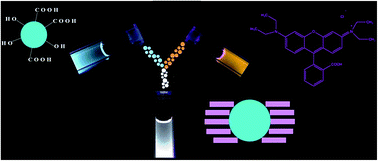White light emission by controlled mixing of carbon dots and rhodamine B for applications in optical thermometry and selective Fe3+ detection†
Abstract
A simple mixing of rhodamine B with fluorescent carbon dots in water led to aggregation of the dye molecules on the carbon dot surface. Controlling the emission of free rhodamine B dye with that of the resultant carbon dot-aggregated rhodamine B composite resulted in efficient white light emission with the CIE coordinate (0.33, 0.32). The white light emitting system can be incorporated into a gel or polymer matrix for solid-state processibility. Further, selective sensing of Fe3+ ions as well as reversible and thermo-responsive emission in the temperature range of 25–80 °C in water shows the versatility in application potential of the nanocomposite.


 Please wait while we load your content...
Please wait while we load your content...